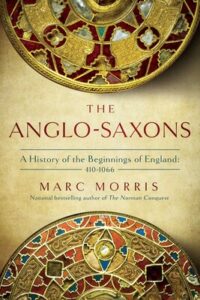
How Myth, Poetry and Literature Helped Create Early Medieval England
Marc Morris on the Origins of the Anglo-Saxons
To understand the earliest Anglo-Saxon kings, it is perhaps best to begin with a story about their contemporaries in Scandinavia. Around the start of the sixth century there was a Danish king called Hrothgar, who ruled for many years with great success, but was brought low by a monster that repeatedly attacked his mead-hall and massacred all his men.
Eventually, after twelve years of despair and devastation, he and his people were saved by a young hero from the neighboring land of the Geats, who defeated and killed the monster with his bare hands, and for an encore went on to dispatch its vengeful mother, who lurked in a lair at the bottom of a lake. Such was the hero’s amazing prowess that he later became king of the Geats, ruled for fifty years, and died in old age defending his people against a dragon.
As a historical source, this story has the disadvantage of being completely made up—the monsters and the dragon are something of a giveaway. The above is a very bald summary of a long poem, known since at least the eighteenth century by the name of its heroic protagonist, Beowulf. Although set in Scandinavia, it is written in Old English by an anonymous author. It survives in only a single manuscript, badly damaged by a fire in 1731.
From the style of its script we can discern that it was written around the year 1000, but most historians think that the poem itself was composed considerably earlier. Based on its content, it cannot have been written before the middle of the seventh century, and despite lots of robust academic debate in recent decades, the majority view remains that it is probably a product of the eighth century. Given that lay literacy at that time was highly restricted, the likelihood is that it was the work of a priest or a monk.
Early students of Beowulf were disappointed that it was preoccupied with monsters and said almost nothing about real historical events or people. Its only apparent link to reality is Beowulf ’s uncle, King Hygelac, who has been tentatively identified as the man who invaded Frisia around 523, which is how we deduce that the poem is probably set in the sixth century.
To understand the earliest Anglo-Saxon kings, it is perhaps best to begin with a story about their contemporaries in Scandinavia.
But these early scholars rather missed the wood for the trees, because while Beowulf is all but useless for reconstructing the politics of sixth-century Scandinavia, it is peerless in illuminating the society of the earliest Anglo-Saxon kings and their subjects. It vividly brings to life a world in which kings dwell in great wooden halls, feasting with their followers, drinking mead, and listening to poets harping about the heroes of old; an era of restless warrior bands in search of adventure, and wandering royal exiles, hoping one day to win back their ancestral thrones.
They carry swords richly worked with precious metals, to which they give names and ascribe mystical protective powers. They fight against each other for glory, but especially for gold, which they prize above all else. A great lord like Hrothgar will deck the interior of his hall with golden tapestries, and decorate its exterior with a golden roof. He will reward his loyal followers with golden war-gear and gold torques. He will be a giver of gold rings.
Much of this world is already familiar to many of us through the novels of J.R.R. Tolkien, and the films of those novels directed by Peter Jackson. Tolkien was a professor of Anglo-Saxon at Oxford, and made his own translation of Beowulf in the early 1920s. Consequently, when he later came to write his famous books, he drew heavily on the poem for inspiration, reworking some of its scenes, borrowing ideas, themes and elements of plot. The people of Rohan in The Lord of the Rings, for example, are essentially Anglo-Saxons as Tolkien imagined them. Their king, Theoden, lives in a golden great hall, and the scene in which he receives Gandalf, Aragorn, Gimli and Legolas closely mirrors a similar scene in Beowulf. Meanwhile, in The Hobbit, Bilbo disturbs Smaug the dragon by stealing a golden cup from his hoard, and the dragon in Beowulf is woken by a thief who does exactly the same.
But while Tolkien borrowed much from Beowulf, he also drew on other sources of inspiration, not least his own Catholic faith. Characters in his novels therefore exhibit Christian virtues such as pity and forgiveness. There is nothing of this in Beowulf. Although the poem is ostensibly Christian—it speaks of a single God, to whom successful characters occasionally give thanks—almost all of the attitudes it celebrates are those of a pagan past. It exalts the loyalty of warriors to their lord, even to the extent of being willing to die for him, and its heroes are overwhelmingly concerned with their earthly renown.
When Beowulf, for instance, is fighting against his second monster, it is not faith that sustains him, but belief in his own reputation, and a desire to win everlasting fame. When Hrothgar’s hall is attacked, Beowulf says it is better to avenge the dead than indulge in mourning. When one brother kills another, their father is sad, but recognizes that it has been done “in accordance with the law of the blood-feud.” This is, in short, a highly unstable world, full of betrayal, vengeance and violence—not just because monsters lurk on its cold, windswept fringes, but because of internal disputes that can be resolved only through bloodshed. The kings and warriors crave success, but they know that it will always be fleeting, and that death and destruction is their ultimate fate.
Beowulf is a much better guide to the earliest Anglo-Saxon kings than some seemingly more sober and bona fide sources. Take, for example, Henry of Huntingdon, who wrote The History of the English in the early twelfth century. “Now when the Saxons subjected the land to themselves,” Henry tells us, “they established seven kings, and imposed names of their own choice on the kingdoms.” He goes on to list these kingdoms in what he implies was their order of creation: Kent, Sussex, Wessex, Essex, East Anglia, Mercia and Northumbria.
It is hard to overstate the enduring impact of this statement. Henry’s confident declaration that there were originally seven Anglo-Saxon kingdoms quickly became an established fact, and gave rise in the sixteenth century to the word ‘heptarchy’, a term that still finds its way into school curriculums today, despite academics suggesting for the past half-century that it should be given a decent burial. Their reason for doing so is that Henry’s assertion rests on no authority at all—he simply listed the more prominent kingdoms he found in his early sources. Bede, for example, mentions all seven of the kingdoms listed by Henry, but he also names several more, bringing his own total to around a dozen. And, as we shall see, Bede’s total was far from comprehensive.
What the Chronicle has to tell us about the origins of the Anglo-Saxon kingdoms therefore is clearly legendary.
Another source on which Henry of Huntingdon drew heavily was the Anglo-Saxon Chronicle—or Chronicles, as some historians prefer. These were initially compiled at the end of the ninth century by scholars working at the court of Alfred the Great, and relate the history of Alfred’s kingdom—Wessex—and its neighbors from the earliest times. The compilers presumably drew on older annals and sources that are now lost, for some of the information they record is demonstrably true. Among the entries for the fifth century, for instance, we find dates for the accession of popes, emperors and bishops which are tolerably accurate. Thus the Chronicle gives the impression of being a credible source even for the earliest period, and for centuries historians were inclined to treat it as such.
The problem is that the entries for the earliest Anglo-Saxon kings look much less credible. Under the year 449, for example, the Chronicle repeats the story told by Bede, about how the Saxons came to Britain in three ships at the invitation of King Vortigern, and were led by the brothers Hengist and Horsa. The Chronicle, though, adds more to the story, describing how Horsa was subsequently killed in a battle against Vortigern, and how Hengist became king of Kent. It also provides similar stories, not mentioned by Bede, about the foundation of other kingdoms.
Sussex, we are told, was founded in 477 when Ælle landed with his three sons in three ships, killed many Britons and drove the survivors into the woods. Wessex, meanwhile, was apparently founded by Cerdic and Cynric, a father-and-son team who beat the Britons, having also arrived in three ships, or possibly five—the Chronicle is confused on this point and has them arriving twice, in both 495 and 514.
What the Chronicle has to tell us about the origins of the Anglo-Saxon kingdoms therefore is clearly legendary. In each case, the founding fathers come to Britain in three ships, and in two instances they do so in alliterative pairs (Hengist and Horsa, Cerdic and Cynric). Sometimes they also give their names to locations associated with their conquests. The place of Cerdic’s landing is said to have been Cerdicesora, and the place of Ælle’s landing was Cymensora, after his son, Cymen. The Chronicle insists that Portsmouth was named after a certain Saxon warrior called Port, and the Isle of Wight after Cerdic’s kinsman, Wihtgar.
Since we know that both Portsmouth and Wight were place names current in the Roman period (Portus, Vecta), we can say with some confidence that the formation actually occurred the other way round: the personal names were concocted from the places, and not vice versa.
As well as being inherently implausible, the stories that suggest Anglo-Saxon kingdoms were being founded from the middle of the fifth century are flatly contradicted by the archaeological record. As we’ve seen, by the end of the century settlers had formed distinct regional identities as Angles, Saxons and Jutes, and it is possible that these may represent some sort of political groupings. But we search in vain within these regions for any evidence of elites. When we look at the remains of early settlements, for instance, what we find is all relatively modest.
Buildings are either fairly humble halls that look to be residences, or else an even more basic type, constructed over a shallow pit, and hence known to archaeologists as sunken-featured buildings (SFBs); these were probably used as workshops or stores. A typical settlement might therefore resemble the one at West Stow in Suffolk, where such buildings have been excavated and reconstructed. There is nothing on such sites to suggest much in the way of social differentiation.
It was from the most successful of these lordships that the earliest kingdoms grew.
It seems that the earliest Anglo-Saxon settlers had set themselves up as free, independent farmers. They took—or were granted by whoever was in charge—enough land to support their family, an amount that they called a hide. Bede helpfully describes a hide as ‘the land of one family’, and its Germanic root, hiwisc, implies a married couple. This family would have lots of dependents to help work the land who were not free—slaves, probably in many cases Britons who had remained in situ or else been rounded up by their new masters.
Such divisions of status seem to be reflected in the earliest cemeteries, in which around half of all adult males were buried with some form of weapon. Since in barbarian societies the bearing of arms was equated with freedom, it seems likely that these were the graves of freemen, or ceorls. By implication, those males buried without weapons would have been their slaves.
In the latter part of the sixth century, however, several changes happen at once. From around 570 there is a sudden and dramatic drop in the number of furnished burials, both male and female—enough to suppose that the practice had been deliberately restricted. At the same time, we find a minority of individuals being interred in extremely ostentatious ways, buried with extravagant quantities of costly items under giant mounds of earth. Such barrows burials had been common enough in Bronze Age Britain, but had seldom been carried out in the intervening 1,500 years. Their reintroduction in the late sixth century signaled the emergence of an elite determined to advertise its superiority. Similarly, when we look at the building record, there is a sudden desire on the part of some to build on a much grander scale, constructing dwellings that dwarfed the modest homes of others.
These changes in the archaeological record accord well with the evidence of place names. Among the commonest types of Anglo-Saxon place names are those ending in -ing or -ingham, elements which mean “the people of” and “the settlement of the people of.” A place name like “Reading,” for example, means “Reada’s people” in Old English, and similarly “Wokingham” means “the settlement of Wocca’s people.” In the nineteenth century, and for a long time into the twentieth, scholars were happy to believe that these names had been introduced into the landscape by the earliest Saxon settlers, and that men like Reada and Wocca must simply have been among the first off the boats. It has since been shown, however, that this was an unfounded assumption, because such place names do not coincide with the earliest archaeological evidence of settlement. It now seems likely that the first examples of -ing and -ingham names date to the late sixth century—the same moment we see signs of rapidly rising elites.
This timing might alter the way we think about such names. There is a tendency to picture places ending in -ing as rather cosy communities, living together because of bonds of kinship—little more than extended families. Beowulf begins with a brief history of King Hrothgar’s people, who are called the Scyldings, after their founding father, Scyld, and it assures us how much they loved their leaders past and present. But it also makes clear that these leaders were lords, and the way they had achieved their dominance was far from benign. Scyld, we are told, had started life as a foundling, but rose to greatness by robbing the halls of others and laying fear upon them, forcing them to pay tribute.
We may suspect that something similar was occurring in late sixth-century Britain, and that men like Reada and Wocca were not necessarily benevolent father figures, but rather men with strong right arms, violent proclivities and boundless greed, asserting control over others, demanding tribute in the form of goods and services. Ceorls who had previously been independent, farming their single hides of land, lords of their own little communities of family and slaves, now found themselves bound to contribute to the upkeep of one particular individual or family that was lording it above the rest.
To see what this might mean in practical terms we have to jump forward a century or so to the time of King Ine of Wessex, who ruled from 688, and laid down the law about what his subjects owed him. From every group of ten hides under his rule, Ine expected an annual render of ten vats of honey, 300 loaves of bread, twelve ‘ambers’ of Welsh ale, thirty of clear ale, two full-grown cows or ten goats, ten geese, ten hens, ten cheeses, an amber of butter, five salmon, twenty pounds of fodder and a hundred eels. The king would have expected this annual render to be delivered to one of the several centers across his domain where he had a dwelling, and presumably the facilities to store it until he and his followers were ready to consume it. We can imagine similar burdens being introduced, to a greater or lesser degree, everywhere in the late sixth century, as ambitious new lords coerced their weaker neighbors into economic and political subservience. And it was from the most successful of these lordships that the earliest kingdoms grew.
__________________________________

Excerpted from The Anglo-Saxons: A History of the Beginnings of England: 410-1066 by Marc Morris. Copyright © 2022. Available from Pegasus Books.
Marc Morris
Marc Morris, PhD, is an historian and broadcaster, specializing in the Middle Ages. An expert on medieval monarchy and aristocracy, Marc has written numerous articles for History Today, BBC History Magazine and Heritage Today; he speaks regularly to schools, historical societies, and literary festivals, and also leads specialist tours of UK castles. He is a fellow of the Royal Historical Society and lives in England.












